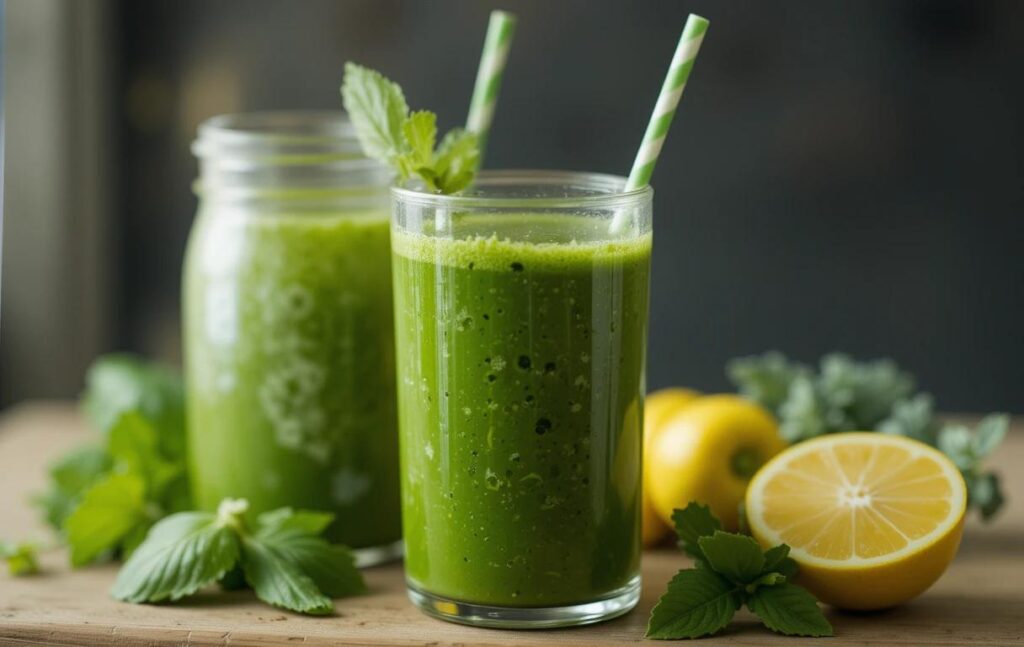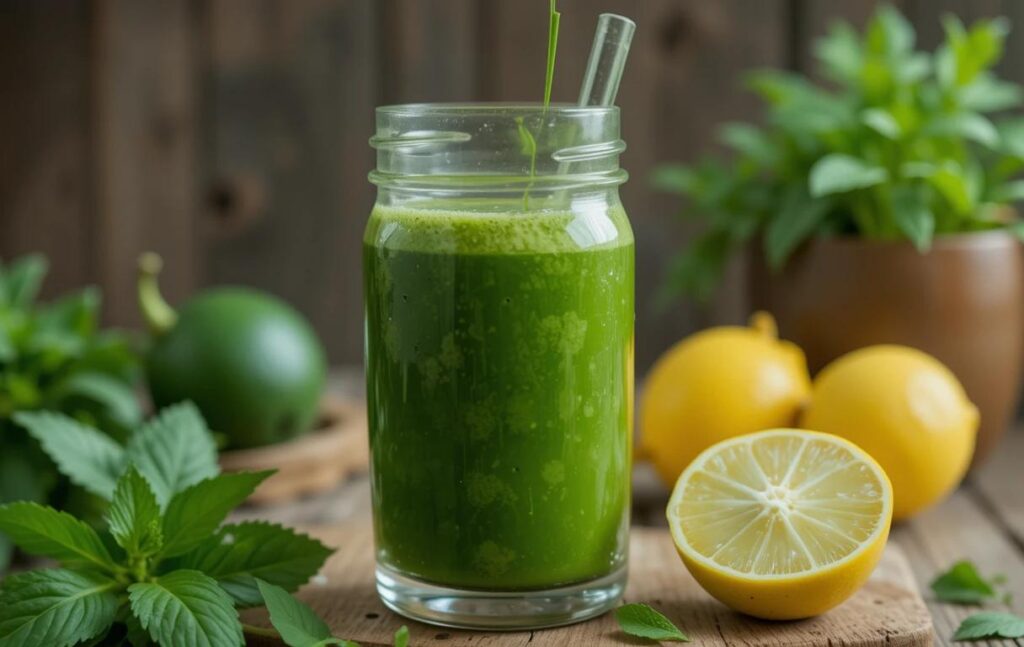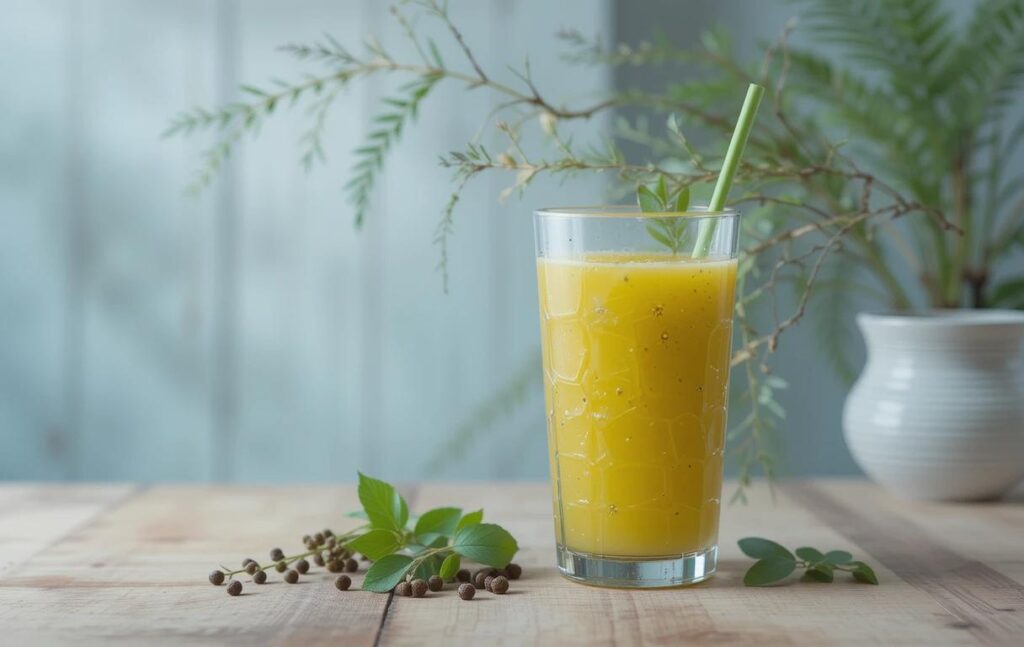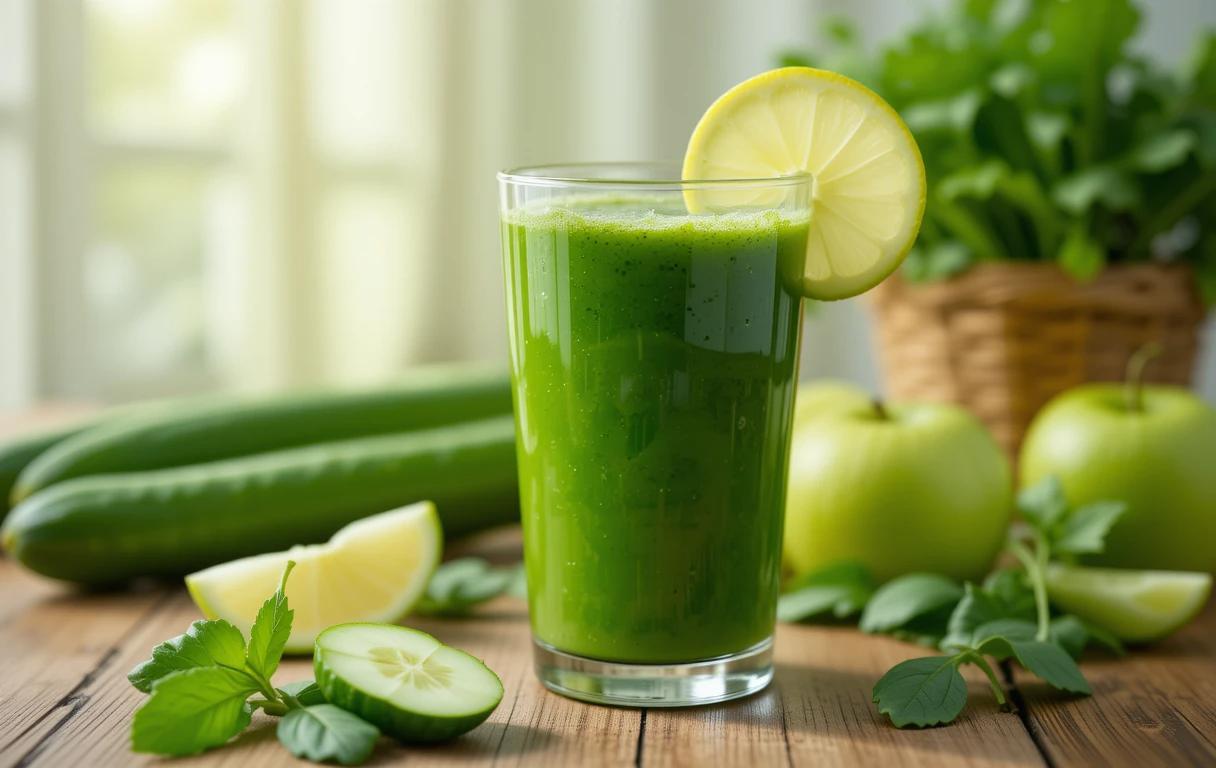Introduction to Juicing Recipes for Weight Loss
Juicing has gained popularity as a powerful and natural method to support weight loss while providing the body with essential nutrients. The concept revolves around extracting juice from fresh fruits and vegetables to create nutrient-dense beverages that are low in calories but high in vitamins, minerals, and antioxidants. These juices can serve as meal replacements, snacks, or supplements to a balanced diet, helping you shed extra pounds and improve your overall health.
Why Juicing for Weight Loss?
- Low-Calorie Nutrient Density: Juices are packed with vitamins and minerals without the extra calories, making them a perfect choice for those looking to manage their weight.
- Boosts Metabolism: Ingredients like ginger, lemon, and leafy greens can accelerate metabolic processes, aiding in fat burning.
- Cleanses and Detoxifies: Fresh juices help flush toxins out of the body, improving digestion and overall well-being.
- Promotes Hydration: Juicing ensures adequate fluid intake, which is essential for maintaining energy levels and curbing hunger.
- Convenient and Customizable: You can tailor recipes to suit your taste preferences and specific dietary goals.
Components of an Effective Weight Loss Juice
To maximize the benefits of juicing, include the following components in your recipes:
- Low-Sugar Fruits: Apples, berries, and grapefruits add flavor and natural sweetness without excessive sugar.
- Leafy Greens: Kale, spinach, and celery provide essential nutrients and are incredibly low in calories.
- Detox Boosters: Ingredients like cucumber, lemon, and mint enhance the body’s natural detoxification process.
- Metabolism Boosters: Ginger, cayenne pepper, and green tea can stimulate fat burning.
- Fiber and Protein Add-ons: While juicing removes fiber, you can complement your juices with chia seeds or a side of protein to maintain satiety.
Tips for Incorporating Juicing into Your Weight Loss Journey
- Start Small: Begin with one juice per day, preferably in the morning, to kick-start your metabolism.
- Stay Balanced: Use juicing as a supplement to whole foods, not a complete diet replacement.
- Watch Your Portions: Stick to recommended serving sizes to avoid excess calorie intake, even from healthy ingredients.
- Stay Consistent: Make juicing a regular part of your routine to see lasting results.
- Experiment with Recipes: Keep your palate interested by trying new combinations of fruits and vegetables.
The Bottom Line
Juicing can be an effective and enjoyable way to support weight loss goals. By choosing the right ingredients and maintaining a balanced approach, you can create delicious beverages that nourish your body and help you achieve your desired weight. Remember, juicing works best when combined with an overall healthy lifestyle, including regular exercise and mindful eating habits.
1. Overview of Juicing for Weight Loss
Juicing for weight loss involves blending or extracting juices from fresh fruits and vegetables to create nutrient-rich beverages. These juices are typically low in calories but high in essential vitamins, minerals, and antioxidants, making them a valuable addition to a weight loss regimen. The approach emphasizes replacing calorie-dense meals or snacks with lighter, healthier alternatives to create a calorie deficit without compromising on nutrition.
Juicing can be adapted to suit various goals and lifestyles, whether through occasional detox days, integrating a single juice into a daily routine, or as part of a comprehensive diet plan. However, while juicing can be a powerful tool for shedding extra pounds, it should be paired with a balanced diet and regular exercise to ensure sustainable and healthy weight loss.
2. Benefits of Juicing for Weight Management
Juicing offers numerous advantages for those aiming to manage or reduce their weight effectively. Here are some key benefits:
a. Low-Calorie Nutrient Intake
Juices allow you to consume a variety of fruits and vegetables in one serving, providing essential nutrients without adding excessive calories. This supports weight loss by creating a calorie deficit while keeping the body nourished.
b. Enhances Metabolism
Certain ingredients, such as ginger, lemon, and cayenne pepper, are known to boost metabolism and promote fat burning, which can accelerate weight loss.
c. Promotes Detoxification
Fresh juices can aid the body’s natural detoxification processes by flushing out toxins, improving digestion, and enhancing liver function. A clean internal system often results in better nutrient absorption and weight management.
d. Curbs Appetite and Reduces Cravings
Drinking a nutrient-dense juice can help suppress hunger and prevent overeating. High water content and natural sweetness from fruits like apples and berries can also satisfy sugar cravings without resorting to unhealthy snacks.
e. Improves Digestion
Juices made with ingredients such as cucumber, spinach, and mint are gentle on the digestive system and can alleviate bloating and other digestive issues. This contributes to a flatter stomach and more efficient nutrient absorption.
f. Supports Hydration
Many fruits and vegetables used in juicing, such as watermelon, cucumber, and celery, are high in water content. Staying hydrated helps maintain energy levels, supports metabolism, and reduces the tendency to mistake thirst for hunger.
g. Convenient and Versatile
Juices are quick to prepare and portable, making them an ideal option for busy individuals looking to maintain their weight. The variety of combinations available ensures you never get bored with the flavors.

Understanding Juicing for Weight Loss
What is Juicing?
Juicing is the process of extracting liquid from fresh fruits and vegetables, leaving behind the fiber-rich pulp. This creates a nutrient-dense beverage that is packed with vitamins, minerals, and antioxidants. Juicing is often used as a dietary supplement to increase nutrient intake or as part of a detox or weight loss plan. Juices are typically consumed fresh and raw, ensuring that the nutrients remain intact and easily absorbed by the body.
How Does Juicing Aid in Weight Loss?
Juicing supports weight loss through several mechanisms:
- Low-Calorie Intake: Juices are usually low in calories, especially when made with vegetables or low-sugar fruits, helping to create a calorie deficit essential for weight loss.
- Nutrient-Dense Choices: Juices deliver essential nutrients like vitamins A, C, and K, and minerals like potassium and magnesium. These nutrients support energy levels and overall health during calorie restriction.
- Hydration: Juices contain a high water content, which aids in hydration and helps curb hunger, preventing overeating.
- Boosts Metabolism: Ingredients like lemon, ginger, and green vegetables can stimulate metabolism and promote fat burning.
- Reduces Cravings: The natural sweetness of fruits and vegetables can satisfy sugar cravings, reducing the desire for unhealthy snacks.
- Cleansing and Detoxification: Juices can support the body’s detox processes, promoting better digestion and reducing bloating, which contributes to a slimmer appearance.
Differences Between Juicing and Smoothies
| Aspect | Juicing | Smoothies |
|---|---|---|
| Preparation | Extracts liquid, removing the pulp and fiber. | Blends whole fruits and vegetables, retaining fiber. |
| Texture | Thin and liquid-like. | Thick and creamy due to retained fiber. |
| Fiber Content | Low, as the fiber is removed. | High, as the entire produce is used. |
| Nutrient Absorption | Nutrients are quickly absorbed, as there’s no fiber to slow digestion. | Nutrients are absorbed more slowly due to the fiber content. |
| Calorie Content | Typically lower in calories. | Higher in calories, especially with added ingredients like yogurt or nuts. |
| Satiety | Less filling due to lack of fiber. | More filling because of the fiber content. |
| Digestive Impact | Easier on the digestive system, ideal for detox. | Supports digestion and gut health due to fiber. |
| Best For | Quick nutrient boost, cleansing, and hydration. | Sustained energy and meal replacements. |
Essential Ingredients for Weight-Loss Juices
Incorporating the right ingredients into your weight-loss juices can maximize their effectiveness and nutritional value. Here’s a breakdown of the essential components for crafting delicious and healthful juices.
1. Fruits: Low-Calorie and High-Fiber Choices
Fruits add natural sweetness and vital nutrients to juices. Choosing low-calorie, high-fiber fruits ensures that you get the necessary vitamins without a significant calorie load.
- Apples: High in fiber (pectin) and low in calories, apples promote satiety and aid digestion.
- Berries (Strawberries, Blueberries, Raspberries): Packed with antioxidants, low in sugar, and supportive of fat-burning.
- Grapefruit: Known for its fat-burning properties and low calorie content, it boosts metabolism.
- Lemon and Lime: Rich in vitamin C and low in calories, they enhance detoxification and flavor.
- Watermelon: Hydrating and refreshing with minimal calories, perfect for weight-loss juices.
- Pineapple: Contains bromelain, which aids digestion, but use sparingly due to its natural sugars.
2. Vegetables: Nutrient-Rich and Low-Sugar Options
Vegetables are the backbone of weight-loss juices, providing essential vitamins, minerals, and antioxidants without adding excess sugar.
- Kale: A superfood loaded with vitamins A, C, and K, and very low in calories.
- Spinach: Mild in flavor and nutrient-dense, it’s perfect for green juices.
- Cucumber: High in water content and low in calories, it’s hydrating and great for detox.
- Celery: A low-calorie ingredient that supports digestion and hydration.
- Carrots: Adds natural sweetness and a dose of beta-carotene, but use moderately.
- Beets: Rich in nitrates and antioxidants, they enhance stamina and detoxification.
- Zucchini: Low in calories and mild in flavor, an excellent addition to green juices.
3. Boosters: Adding Herbs, Spices, and Superfoods
Boosters amplify the health benefits of your juices by enhancing flavor, supporting metabolism, and promoting detoxification.
- Ginger: Stimulates digestion, reduces bloating, and boosts metabolism.
- Turmeric: Contains curcumin, a potent anti-inflammatory that aids weight loss.
- Mint: Refreshing and aids digestion, reducing bloating.
- Cayenne Pepper: Contains capsaicin, which increases fat burning and boosts metabolism.
- Chia Seeds: High in fiber and omega-3s, they help curb hunger (soak before adding to juice).
- Flaxseeds: A good source of fiber and healthy fats, they support weight management.
- Green Tea or Matcha Powder: Packed with antioxidants and metabolism-boosting properties.
- Spirulina or Wheatgrass: Superfoods that detoxify and provide essential nutrients for energy and fat burning.
- Apple Cider Vinegar: Aids digestion and helps control blood sugar levels when used in small amounts.
Top Juicing Recipes for Weight Loss

Here are five delicious and nutrient-packed juicing recipes designed to help you lose weight while keeping your body nourished and energized. Each recipe targets specific weight-loss benefits, such as detoxification, fat burning, and boosting metabolism.
1. Green Detox Juice
This juice is packed with leafy greens and hydrating vegetables to cleanse your body and flush out toxins.
Ingredients:
- 2 cups spinach
- 1 cup kale
- 1 cucumber
- 2 celery stalks
- 1 green apple (for sweetness)
- ½ lemon (peeled)
- 1-inch piece of ginger
- ½ cup water or coconut water (optional for consistency)
Instructions:
- Wash all ingredients thoroughly.
- Juice the spinach, kale, cucumber, celery, apple, lemon, and ginger.
- Stir and enjoy immediately for maximum freshness.
Benefits: Detoxifies the body, supports digestion, and boosts hydration.
2. Tropical Fat Burner Juice
A refreshing, fruity juice with fat-burning properties to keep you energized and satisfied.
Ingredients:
- 1 cup pineapple chunks
- 1 orange (peeled)
- 1 carrot
- 1 cucumber
- ½ lime (peeled)
- 1-inch piece of turmeric
Instructions:
- Peel and chop the orange, carrot, and lime.
- Juice all ingredients together.
- Serve chilled for a tropical treat.
Benefits: Promotes fat breakdown, reduces inflammation, and supports metabolism.
3. Spicy Metabolism Booster Juice
This juice features spices that kickstart your metabolism and encourage calorie burning.
Ingredients:
- 1 grapefruit (peeled)
- 1 green apple
- ½ cucumber
- 1-inch piece of ginger
- A pinch of cayenne pepper
- ½ lemon (peeled)
Instructions:
- Juice the grapefruit, apple, cucumber, ginger, and lemon.
- Sprinkle a pinch of cayenne pepper into the juice and stir well.
- Enjoy with ice for a spicy kick.
Benefits: Enhances metabolism, aids digestion, and helps reduce bloating.
4. Morning Citrus Kickstart Juice
A vibrant, energizing juice perfect for starting your day with a metabolism boost.
Ingredients:
- 2 oranges (peeled)
- 1 grapefruit (peeled)
- ½ lemon (peeled)
- 1-inch piece of ginger
- 1 carrot
Instructions:
- Peel and chop all ingredients.
- Juice the oranges, grapefruit, lemon, ginger, and carrot.
- Serve fresh to jumpstart your morning.
Benefits: High in vitamin C, improves digestion, and provides a natural energy boost.
5. Beetroot and Berry Energizer
This juice combines the detoxifying power of beets with the antioxidant benefits of berries.
Ingredients:
- 1 medium beetroot (peeled)
- 1 cup mixed berries (blueberries, raspberries, strawberries)
- 1 green apple
- ½ lemon (peeled)
- ½ cup water (optional for consistency)
Instructions:
- Wash and chop all ingredients.
- Juice the beetroot, berries, apple, and lemon.
- Stir well and enjoy its vibrant color and taste.
Benefits: Detoxifies the liver, boosts energy levels, and reduces oxidative stress.

Frequently Asked Questions (FAQs)
1. Can juicing replace meals for weight loss?
Juicing can replace occasional meals, particularly breakfast or a snack, but it is not advisable to use it as a long-term meal replacement strategy. Juices lack protein, fiber, and healthy fats, which are essential for sustained energy and muscle maintenance. For weight loss, use juicing as a supplement to a balanced diet rather than a complete replacement.
2. How often should I juice to lose weight?
The frequency depends on your goals and lifestyle:
- Daily Juicing: A single juice daily, such as a green detox juice, can complement your diet.
- Short-Term Detox: A 1–3 day juice cleanse can kickstart weight loss but should not exceed this duration.
- Weekly Juicing: Incorporate juicing 2–3 times per week to maintain consistency and provide your body with a nutrient boost.
Remember, moderation is key, and juicing works best when combined with whole foods and regular exercise.
3. Are there any risks associated with juicing?
Yes, while juicing has many benefits, there are potential risks:
- Nutrient Imbalance: Relying solely on juices can lead to a lack of protein, fats, and essential fiber.
- Blood Sugar Spikes: Juices high in fruit content may cause blood sugar spikes, especially in individuals with diabetes or insulin resistance.
- Low Satiety: The absence of fiber may lead to hunger shortly after consuming juice.
- Digestive Sensitivity: For some, juicing may cause bloating or discomfort if consumed in excess.
To minimize risks, focus on a balanced approach, using vegetables as the primary ingredient and limiting high-sugar fruits.
4. What equipment do I need for juicing?
To get started, you’ll need:
- Juicer: Options include:
- Centrifugal Juicers: Fast and budget-friendly but less efficient in extracting juice from leafy greens.
- Masticating (Cold Press) Juicers: Slower but retain more nutrients and yield higher-quality juice.
- Knife and Cutting Board: To prepare fruits and vegetables.
- Storage Bottles: Use glass bottles to store any leftover juice.
- Optional Add-ons: Strainers (for smoother juice) and a brush for cleaning the juicer.
5. Can I store juices, and how long do they last?
Yes, you can store juices, but fresh juice is always best to maximize nutrient retention. If storing:
- Refrigeration: Store in airtight glass containers for up to 24–48 hours.
- Freezing: For longer storage, freeze juices for up to 3 months, but this may slightly reduce nutrient content.
- Tip: Fill containers to the brim to minimize air exposure and nutrient loss.
Avoid storing juices containing ingredients like bananas or avocados, as they can quickly spoil or separate.
6. Do juices help with belly fat reduction?
Juices can support belly fat reduction indirectly by:
- Reducing Calorie Intake: Low-calorie juices help create a calorie deficit, essential for fat loss.
- Boosting Metabolism: Ingredients like ginger, lemon, and cayenne pepper may aid fat burning.
- Improving Digestion: Juices with detoxifying ingredients (e.g., cucumber, celery) reduce bloating and support gut health.
However, no juice specifically targets belly fat. Sustainable fat loss requires a combination of juicing, whole foods, regular exercise, and stress management.
Conclusion
Summarizing the Benefits and Importance of Healthy Juicing
Healthy juicing is a convenient and enjoyable way to support weight loss while nourishing your body with essential vitamins, minerals, and antioxidants. By incorporating low-calorie fruits, nutrient-rich vegetables, and metabolism-boosting herbs or spices, juicing can aid in detoxification, improve digestion, and boost energy levels. It’s an effective method to increase your daily intake of fresh produce, hydrate your body, and promote overall wellness.
When done thoughtfully, juicing complements a balanced diet and can play a pivotal role in achieving your weight-loss goals. Its versatility allows for countless combinations to suit individual tastes and needs, ensuring that the journey to a healthier lifestyle is both delicious and rewarding.
Encouraging Safe and Sustainable Weight Loss Practices
While juicing is a valuable tool for weight management, it’s essential to approach it responsibly. Prioritize whole, nutrient-dense ingredients and avoid relying solely on juices as meal replacements for extended periods. Incorporate juices into a balanced diet that includes proteins, healthy fats, and fiber-rich foods to maintain energy levels and long-term health.
Sustainable weight loss requires consistency, moderation, and a focus on overall lifestyle changes. Pair juicing with regular physical activity, adequate hydration, and mindful eating habits for optimal results. Always listen to your body, and consult a healthcare professional if you have any medical conditions or concerns.
Final Thoughts
Juicing can be a powerful ally in your journey toward safe and sustainable weight loss. By making it a part of a holistic approach to health, you can enjoy its many benefits while achieving your goals in a way that is both effective and enduring. Start small, experiment with different recipes, and savor the process of nourishing your body and mind with every sip.
For More Recipes
a pretty life in the suburbs marshmallow vanilla buttercream
mississippi mud pie ice cream
boston cream pie near me
vegan barley soup

